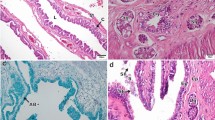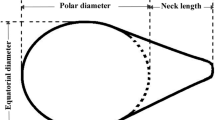Abstract
In many species of animals, males normally produce parasperm (dimorphic sperm) along with eusperm (normal sperm) during spermatogenesis. In the present study, to clarify the role of parasperm of the non-copulatory sculpin Hemilepidotus gilberti, whose reproduction is characterized by polyandrous oviposition involving sneaking by neighboring territorial males, we observed the movements of parasperm. Parasperm could not move by themselves, but they were transported in solutions by passive movement due to collisions with actively swimming eusperm. In the viscous ovarian fluid (OF), which isolates eggs from seawater by covering them during spawning, parasperm did not exhibit any movement. However, they could be transported by eusperm movement in solutions with dissolved OF, partly because the viscosity of the fluid become lower. And then, in some solutions parasperm formed lumps. Lump formation of parasperm was also observed at the boundary surface of an egg mass where OF contacted seawater. Eusperm added experimentally to a solution in which parasperm were forming lumps were engulfed in the lumps and never escaped. Thus, lump formation of parasperm would be obstacles for the later arriving eusperm. Although lumps formed against both kin and non-kin eusperm, parasperm are thought to be available to overcome sperm competition which would occur during spawning that involves sneaking being almost concurrent with lump formation. The territorial male eusperm reach the eggs while his parasperm hinder other males' eusperm from reaching the eggs. Thus, we concluded that parasperm of H. gilberti play a role on protection of paternity by blocking rival eusperm physically from approaching eggs.
Similar content being viewed by others
References cited
Afzelius, B.A. 1992. Spermatozoa and evolution. pp. 196–211. In:M. Morisawa & M. Hoshi (ed.) Seishigaku (Spermatology), University of Tokyo Press, Tokyo (translated to Japanese by K. Sano).
Baker, R.R. & M.A. Bellis. 1988. 'Kamikaze' sperm in mammals? Anim. Behav.36: 936–939.
Buckland-Nicks, J., D. Williams, F.S. Chia & A. Fontaine. 1982. Studies on thepolymorphic spermatozoa of a marine snail. I - Genetics of the apyrene sperm. Biol. Cell 44: 305–314.
Chauvaud, L., J. Cosson, M. Suquet & R. Billard. 1995. Sperm motility in turbot, Scophthalmus maximus: initiation of movement and changes with time of swimming characteristics. Env. Biol. Fish. 46: 341–349.
Cook, P.A. & N. Wedell. 1998. Non-fertile sperm delay female remating. Nature 397: 486.
Hann, H.M. 1930. Variation in spermiogenesis in the teleost family Cottidae. J. Morphol. Physiol. 50: 393–411.
Hayakawa, Y., A. Komaru & H. Munehara. 2001. Ultrastructural observations of eu-and paraspermiogenesis in the cottid fish Hemilepidotus gilberti (Teleostei: Scorpaeniformes: Cottidae). J. Morphol. (in press).
Hayakawa, Y. & H. Munehara. 1996. Non-copulatory spawning and female participation during early egg care in a marine sculpin Hemilepidotus gilberti. Ichthyol. Res. 43: 73–78.
Hayakawa, Y. & H. Munehara. 1998. Fertilization environment of the non-copulating marine sculpin, Hemilepidotus gilberti. Env. Biol. Fish. 52: 151–186.
Hayakawa, Y. & H. Munehara. 2001. Facultatively internal fertilization and anomalous embryonic development of a noncopulatory sculpin Hemilepidotus gilberti Jordan and Starks (Scorpaeniformes: Cottidae). J. Exp. Mar. Biol. Ecol. 256: 51–58.
Hayakawa, Y., H. Munehara, R. Akiyama & A. Komaru. 2000. Paraspermatozoa in a cottid fish. J. Reprod. Develop. 46 (Suppl.): 81–82.
He, Y. & T. Miyata. 1997. Variations in sperm number in relation to larval crowding and spermatophore size in the armyworm Pseudaletia separata. Ecol. Entomol. 22: 41–46.
Healy, J.M. & B.G.M. Jamieson. 1981. An ultrastructural examination of developing and mature paraspermatozoa in Pyrazus ebeninus (Mollusca, Gastropoda, Potamididae). Zoomorphology 98: 101–119.
Hodgson, A.N. 1997. Paraspermatogenesis in gastropod molluscs. Invert. Reprod. Dev. 31: 31–38.
Jamieson, B.G.M. 1987. A biological classification of sperm types, with special reference to annelids and molluscs, and an example of spermiocladistics. pp. 311–332. In: H. Mohri (ed.) New Horizons in Sperm Cell Research, Japan Scientific Societies Press, Gordon and Breach Science Publishers, New York.
Kura, T. & Y. Nakashima. 2000. Conditions for the evolution of a soldier sperm class. Evolution 54: 72–80.
Meves, F. 1903. Üeber oligopyrene und apyrene Spermien und über ihre Entstehung, nach Beobachtungen an Paludina und Pygaera. Arch. F. Mikrosk. Anat. 61: 1–84.
Moore, H.D.M., M. Martin & T.R. Birkhead. 1999. No evidence for killer sperm or other selective interactions between human spermatozoa in ejaculates of different males in vitro. Proc. R. Soc. Lond. B 266: 2343–2350.
Osanai, M., H. Kasuga & T. Aigaki. 1987. Physiological role of apyrene spermatozoa of Bombyx mori. Experientia 43: 593–596.
Parker, G.A. 1970. Sperm competition and its evolutionary consequences in the insects. Biol. Rev. 45: 525–567.
Quinitio, G.F. & H. Takahashi. 1992. An ultrastructural study on the occurrence of aberrant spermatids in the testis of the river sculpin, Cottus hangiongensis. Japan. J. Ichthyol. 39: 235–241.
Quinitio, G.F., A. Goto & H. Takahashi. 1992. A comparison of the annual changes in testicular activity and serum androgen levels between the early and delayed maturing groups of male Cottus hangiongensis. Env. Biol. Fish. 34: 119–126.
Quinitio, G.F., H. Takahashi & A. Goto. 1988. Annual changes in the testicular activity of the river sculpin, Cottus hangiongensis Mori, with emphasis on the occurrence of aberrant spermatids during spermatogenesis. J. Fish Biol. 33: 871–878.
Siebold, C.T. von. 1836. Fernere Beobachtungen über die Spermatozoen der wirbellosen Tiere. 2. Die Spermatozoen der Paludina vivipara. Muller's Arch. Anat. Physiol. Wiss. Med. 1: 232–256.
Silberglied, R.E., J.G. Shepherd & J.L. Dickinson. 1984. Eunuchs: the role of apyrene sperm in Lepidoptera? Amer. Nat. 123: 255–265.
Sivinski, J. 1984. Sperm in competition. pp. 85–115. In: R.L. Smith (ed.) Sperm Competition and the Evolution of Animal Mating System, Academic Press, New York.
Snook, R.R. 1998. The risk of sperm competition and the evolution of sperm heteromorphism. Anim. Behav. 56: 1467–1507.
Author information
Authors and Affiliations
Rights and permissions
About this article
Cite this article
Hayakawa, Y., Munehara, H. & Komaru, A. Obstructive Role of the Dimorphic Sperm in a Non-copulatory Marine Sculpin, Hemilepidotus gilberti, to Prevent Other Males' Eusperm from Fertilization. Environmental Biology of Fishes 64, 419–427 (2002). https://doi.org/10.1023/A:1016142902511
Issue Date:
DOI: https://doi.org/10.1023/A:1016142902511




